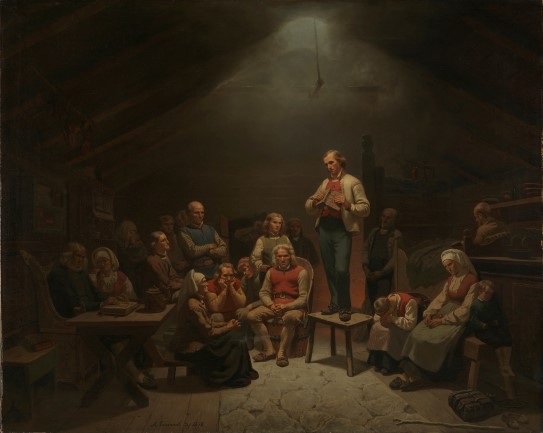Low Church Devotion (audio description)
Adolph Tidemand
Transcription
Description
Low Church Devotion, also known as The Haugians
Artist: Adolph Tidemand
Year: 1848
The artwork is an oil painting on canvas. Inside a dark smokey room, a man is standing on a stool with a book in his hands while talking to a group of seated women, men and children. It is apparently faithfully rendered and the main character is illuminated by a lyre; a hole in the ceiling. The composition of people, light and space creates a kind of pyramid shape. The faces of the audience show clear and different emotional expressions.
Narrator:
Adolph Tidemand is applying the finishing touches to Low Church Devotion, also known as The Haugians, at his home in Düsseldorf, Germany. It’s a turbulent time in Europe. The painting, which at first glance appears to show Norwegian farmers, gathered together in a harmonious and theatrically lit scene, is in fact a portrayal of a criminal act. Eilif Salemonsen, an art historian at the National Museum, explains.
Eilif Salemonsen:
When you see this painting for the first time, it's not obvious that you are looking at an illegal gathering. Everyone in the painting is breaking the law. Right up until 1842, it was a criminal offence in Norway to convene a religious gathering outside a church, unless one had permission from the parish priest. And the ordinary Norwegian farmers we see gathered here are Haugeans, followers of the travelling lay preacher Hans Nielsen Hauge.
Narrator:
Hauge’s followers defied the clergy’s monopoly on preaching the gospel. They emphasized the importance of personal faith and individual responsibility and enterprise. Tidemand shows us individuals who are responding to the preacher’s words in different ways.
Both the struggles of the Haugean movement and Tidemand’s painting are Norwegian expressions of cultural trends in Europe.
Eilif Salemonsen:
The 1840s, when Tidemand painted this picture, was also a time when ideas about freedom and democratization were gaining ground elsewhere in Europe. For example, just after Tidemand finished this painting, revolutions and riots broke out all over Europe, including in Düsseldorf, where Tidemand worked and lived with his family. People were fighting for things like universal male rights to vote, and better rights and working conditions for Europe’s growing working class.
Narrator:
So we can interpret this painting in the light of struggles for freedom and democracy. And perhaps Tidemand also wished to placate his own father-in-law, a devout follower of Hauge.